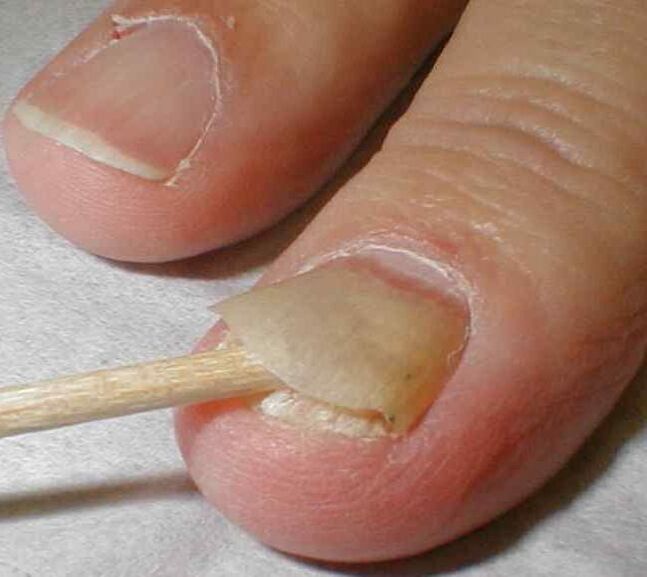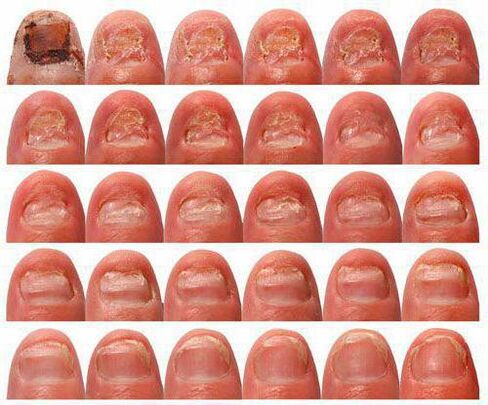This article will focus on this unpleasant but very common phenomenon, such as toenail fungus. The symptoms and causes of the disease are known to the medical profession and can be easily diagnosed at all stages. However, it can only be detected by taking care of your own health. How to identify toenail fungus? How to treat it? Is the advertising ointment effective?

What causes nail fungus?
Nail fungus is a fairly common disease. The disease spreads particularly successfully in places with temperate and tropical climates (ie, humid and warm places). Paradoxically, however, residents of cold countries suffer from nail fungus most often. This is due to the fact that in bad weather, you must always wear warm shoes with socks. The feet sweat and the socks become wet. People are forced to stay in this state for a long time without the opportunity to change shoes. This is the best way to promote the formation of nail fungus. Before discussing how to identify toenail fungus, let us figure out who is more susceptible to this disease.
Nail fungus is an occupational disease
People whose feet cannot breathe during the day due to tight shoes are at risk. These are representatives of miners, power plant workers, gardeners and other job professions. You can "pick up" the fungus by working in the laundry room, swimming pool, hotel, restaurant.
Which diseases can be used as a prerequisite
Usually, not only the representatives of the above occupations suffer from this disease, but also people with type 1 or type 2 diabetes suffer from this disease. In addition, deformities of the feet and varicose veins may be a prerequisite for the formation of nail fungus. One of the causes of infection is insufficient nutrition of nails due to clogged or blocked blood vessels. This is why the creams advertised today and nail polishes that are said to protect against fungi will be completely useless in fighting diseases. After all, this is usually caused by internal diseases, and external influences will not eradicate the problem.
Who is in danger?
Decades ago, in most cases, nail fungus was diagnosed in the elderly. However, the number of people suffering from nail fungal disease is increasing every year, and the disease itself is getting younger and younger.
Official data show that the growth frequency of nail fungus in men is 2 to 3 times that of men. At the same time, it is precisely this problem that women turn to dermatologists more. Fairer sexes are more concerned about their health and will not find anything shameful when consulting a doctor.
Next, we will consider why it is so important to get advice on fungal treatment from a dermatologist, and we will also discuss how to determine the fungus on the nails and what symptoms the fungus has at each stage of its development.

What does nail fungus look like?
This disease is not fatal, but of course it is necessary to eliminate it. Fortunately, it is easy for anyone to recognize the onset of a disease. How to identify the fungus on the feet? See the tips below. First, take a closer look at your nails.
The first thing to pay attention to is the color of this nail polish. Fungus-infected nails darken, dark yellow, and opaque. Depending on the stage of the disease, the edge, base or the entire nail may be affected.
Pay attention to the thickness of your nails
When answering the question of how to determine nail fungus, the changes in the nail plate should also be mentioned. Although the nails become thinner visually and sensorily due to the disease, they look thicker and swollen.
How to identify nail fungus? To detect the presence of infection, visual inspection of the nail plate is not enough. Mix potassium permanganate and water in a ratio of 1 to 5, and immerse the nail in the resulting solution for half a minute. Healthy nails will be colored and brown. Part of the affected board will remain white.
Stage of disease
The disease is divided into four stages. The sooner you start treatment, the more likely you are to get rid of nail fungus permanently.
The first stage is characterized by damage to the edges of the nails. As mentioned above, the color of the board changes and bulges appear. The nails are of poor growth quality and are hollow, so they can break and rupture.
The increase in the area of the lesion will be a sign of the second stage. In addition, it should be noted that sometimes the second phase can start as if bypassing the first phase. The destruction of the nail plate does not start from the edge, but from the bottom of the nail. Compared with the first stage, recovery from nail fungus in the second stage will face greater problems.
How to identify stage 3 toenail fungus? In medicine, it is called a white surface fungus, and it looks like the entire plate is affected. It has a dense white color and its edges are strongly collapsed.
The fourth stage is called total vegetative fungus. The nails were yellowish-gray with a special unpleasant smell and disintegrated strongly. In the fourth stage, you can often see the exposed part of the skin with a broken nail, because it grows due to fungus and will fall off in most cases.

The reason for contacting a dermatologist is usually the independent identification of the fourth stage of nail fungus. Do not search forums or the Internet for advice on how to effectively treat nail fungus. It is best to consult an expert on the first symptoms of the disease.
What to expect from seeing a doctor?
Maybe in each of us, there is a fear of doctors. However, if you suspect that you have nail fungus, don't be afraid to contact a dermatologist. The expert will conduct an external examination and scrape the upper stratum corneum of the nail to send it to the laboratory for diagnosis. A detailed analysis will reveal the cause of the disease, determine the type of fungus, and tell the doctor which treatment to prescribe.
The treatment of nail fungus takes a long time. It can last from one month to three months. After the course of treatment, even if the above symptoms are not observed, it needs to be checked again.
A few words about effective treatment
So now we know how to identify toenail fungus. These methods are given above. Now, it is worth mentioning the treatments you can do yourself. The drug Naftifine has proven itself to be very effective. However, you don't need to use ointment, you can use a solution. This medicine can also be used if the foot has a fungal infection.
How to use naftifine? If there is fungus in the first stage of the disease, lubricate the affected area of the nail twice a day. Keep the nails dry and wash them. In the next stage of the disease, you have to take medicine. However, in this case, the use of Naftin should not be stopped: this will enhance the effect of the drug's action.
Before applying the product, use a manicure device to thoroughly clean the affected area. However, you need to be extra careful when doing this. After a perfect operation, it is necessary to apply the Naftine solution to the cleaned area. Repeat twice a day.
to sum up
This article provides answers to the question of how to identify toenail fungus. However, it is worth remembering that self-medication does not always lead to a complete recovery. If the thickness or color of the nail changes, consult a doctor.
According to the degree of damage to the nail plate, fungus can be divided into four stages. If the disease does not cause an alarm in the first stage because it does not severely deform the nail plate, then you can easily lose your nails in the fourth stage. Don't hesitate to contact a dermatologist.
It is strongly recommended that you refrain from self-medication, because advertisements about the efficacy of specific medicines are cautioned. The cream or any other medicament applied to the nail plate from the outside will not eliminate the pathogen of the disease and therefore will be ineffective. As a result, you will only delay the treatment process and cover up the manifestations of the disease. It is also worth mentioning that not only does the nail fungus look unsightly, but it is also a beacon that indicates the presence of disease in the body.
















